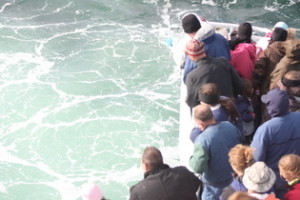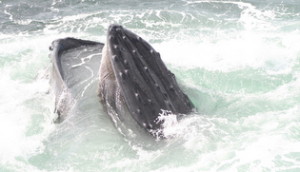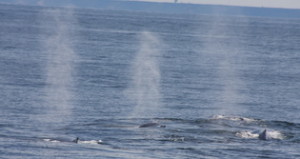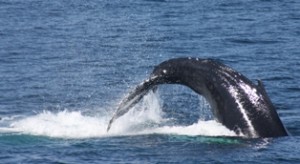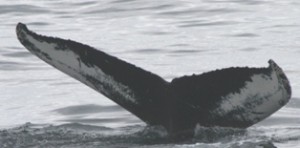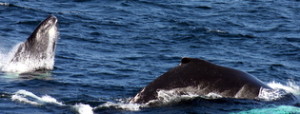Dolphin Fleet Naturalist Notebook, October 10 to October 15
10 October– Saturday was overcast with northwesterly winds. Today we return to the triangle, a likely area to find whales. On the morning watches several humpback whales were sighted. Although occasionally the whales would surface feed, most of the time the dives were long and the whales surfaced energetically. It seemed as if the small fish that comprise their diet were well beneath the surface. A small humpback whale continually slapped its flukes on the surface- a behavior called lobtailing.
One Minke whale was sighted in the area amidst the larger humpbacks. It seems the size of a dolphin but is in fact about 20 feet (6.1 meters) long! The Minke whale is also known as the little piked whale, because of its pointed snout visible when the whale first surfaces. In the waters off Cape Cod, Minkes are sighted year round, yet, little is known about their lives. Sightings here are primarily of one individual or small groups of two or three. Unlike other species in the area, it is rare to see mothers with calves. Some researchers speculate that the Minkes of Cape Cod are primarily juveniles. Abundant in number world-wide, Minkes are the most heavily hunted baleen whale. Despite a moratorium on commercial whaling, over 1400 Minkes are killed each year in commercial hunts off Iceland, Norway, in the North Pacific and the Southern Ocean Whale Sanctuary.
Many of the humpback whales photographed today have been sighted in the area for several weeks. They include: Cajun, Milkweed, Whisk, Ventisca, Leonid, Eruption, Mostaza, Aerospace, Ravine, Nazka, Polaris, Belly, Echo, Buzzard, and Bolide and Anchor and their calves. By afternoon the winds and seas increased dramatically and we had to head back to shore.
11 October– Sunday is bright with westerly winds. Rounding the breakwater we see the dramatic dunescape of Provincetown and Truro. Not so long ago it was believed that Cape Cod had risen from the sea, its ever changing dunes and sandbars sculpted into being by the currents and tides. In fact, the Cape as we see it today is the result of glaciers passing, a series of massive ice sheets that swept down our continent from the North, carving out the geology of its land and ocean floor, covering the dry coastal plains, hills and marshes. The last continental glacier in North America, approximately 15,000 years ago, was the Laurentide ice sheet, sculpting out the land as it advanced towards New England. As the glacier retreated, two glacial lobes emerged, one forming Cape Cod Bay, the bordering land to the west, and to the North, Stellwagen Bank. The other lobe, extending east of the Cape formed the area known today as the Great South Channel, as well as Martha’s Vineyard, Nantucket and George’s Bank.
On our watches today we returned to the triangle and in the morning, several humpback whales. By early afternoon some of the humpbacks were kick feeding and surfacing with mouths open and full of water and small fish. We photographed Eruption, Ventisca, Belly, Moonlight, Mostaza, Aerospace, Cajun, Pinpoint, Ember, Division, Tear, Dome, Cosmos, Ampersand, Echo, Tectonic, Buzzard and Thumper and calf. By late afternoon there were a few Minke whales moving about the area and a few humpback whales. Two of the whales were breaching in the distance but we had excellent views of Lavaliere and her second calf.
12 October– Monday was bright with light winds. Today our destination was the triangle, but just east of Stellwagen Bank we spotted our first whale spouts. All of the whales appeared to be humpbacks and several of them small- perhaps calves of last year. One of the small whales was flipper slapping and 3 others including Zeppelin and her calf were resting at the surface, a behavior called logging. Mostaza, Milkweed, Cajun, Ventisca, Echo and Tectonic were moving about the area and spending several minutes beneath the surface.
By afternoon most of the humpbacks were kick feeding and lunging at the surface feasting on small schooling fish. In the feeding mix was Bat’s 08 calf, Bolide and calf, Division, Echo, Tectonic, Mostaza, Nazka, Lavaliere and her calf and one Minke whale. Seeing so many humpback whales it is important to remember that their populations were decimated by commercial whaling. Although generally increasing in number, some populations of humpback whales remain small in number.
Cape Cod Whaling
Native Americans were the first whalers of Cape Cod, using the whale’s meat, oil and bone. The earliest form of whaling off Cape Cod was the use of drift whales and beached or stranded whales often dying or recently dead. However it is possible that Native Americans were hunting whales at sea in the early 17th century. Early European settlers learned from the Natives and harvested whales that washed ashore. The Natives in turn, learned how to render whale oil from the Europeans who had been whaling since at least the 12th century. Prior to the arrival of the settlers, the Natives took whales primarily for food. The Europeans also ventured out to hunt whales in Cape Cod waters. In later years, crews had to venture further offshore to find desirable whales, their journeys eventually taking them as far as the North Pacific. The North Atlantic right whale, a seasonal resident of Cape Cod Bay whose oil lit the lamps of the western world and whose baleen was used for carriage springs, whips and other items, was virtually extinct by the late 1700’s.
In 1760, Provincetown had a fleet of a dozen whaling ships. As whaling came of age in New England, Provincetown suddenly transitioned from a quiet fishing village to a bustling seaport. By the mid-1800’s, Provincetown’s large and safe harbor became one of the busiest seaports in the country, the fifth largest whaling port with fifty-six wharves and a fleet of over 700 vessels. Whaling was declining at the end of the 1800’s due to factors including dropping whale populations and the discovery of kerosene, a replacement for whale oil. Then in 1898, a storm known as the Portland Gale destroyed many of the wharves in town. The era of Provincetown’s fame as a major seaport had ended. The harpoons and guns were replaced over a century later by cameras, binoculars and a new generation of seafarers- whale watchers.
Nazka kick-feeds
13 October– Tuesday was overcast with occasional showers and choppy seas. The morning watch traveled to the triangle where there were several humpback whales. Milkweed, Cajun and 2 small unknown whales were on deep dives. However Thumper and calf stayed on the surface for several minutes at a time and the calf occasionally breached.
By late morning the seas began to build so we traveled just west of Stellwagen Bank. We sighted several humpback whales in the area- but just as the downpour began. We also sighted a grey seal before we traveled back to Provincetown- waterlogged!
Seals of Cape Cod
Other than cetaceans, seals are the only other marine mammal found in Cape Cod waters since our waters are too cold for manatees and too warm for polar bears. All seals are called pinnepids, derived from the Latin meaning wing- or feather-footed. They have a streamlined, torpedo-shaped body adapted for swimming and unlike whales, have not totally abandoned
land. They use it to give birth to and suckle their pups and are often seen basking on coastal islands and sandbars. Seals primarily eat fish and invertebrates; the most common prey for Cape Codseals include squid, herring, mackerel and sand lance. Our most commonly seen seals are harbor seals, primarily seen in winter, and grey seals, large-bodied and robust, seen near shore off our ocean beaches all seasons, especially in summer.

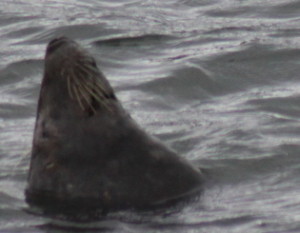
14 October– Wednesday was bright with hefty seas. We ventured offshore during the afternoon hoping that the seas had subsided since the winds of the afternoon before. There still was a heft swell but we were able to find Ganesh and calf and a small juvenile humpback southeast of Stellwagen Bank. Despite the 4 to 6’ seas, we were able to get excellent views of the calf . Ganesh’s calf was born in the warm waters of the Caribbean Sea during the winter. The calf was able to swim immediately and soon learned to nurse on the fat-rich milk of its mother, gaining about 100 pounds (45.5 kg) per day. In early winter, Ganesh and calf began the long migration across the open ocean to the waters off Cape Cod. Fasting in the Caribbean, Ganesh needs to eat and her calf now has enough blubber for cold water. By now, the calf is about six to 10 months old and will begin to learn how to catch the small fish and shrimp abundant in these waters. In a few months, the calf will be weaned, and shortly after will separate from Ganesh.
International Citizens
Like many whales, humpbacks are international citizens, crossing country borders as they migrate great distances each year. The migration relates to the life cycle of the whale, as they feed during the summer in Northern waters and breed and calve during winter months towards the equator. During the winter, the majority of the population congregates to mate and calve among the reefs and islands of the West Indies. Humpbacks leave the breeding areas in spring to migrate to several high-latitude feeding areas during spring and summer months including the Gulf of Maine, the Gulf of St. Lawrence, Newfoundland-Labrador, Greenland, Iceland, and Norway. Fidelity, or faithfulness, to feeding areas is well documented. While on the tropical breeding grounds, humpbacks from all feeding areas can be seen swimming side-by-side – yet each year, the humpback whales of Cape Cod return to their ancestral feeding grounds- as do their calves once they leave their mothers’ side.
Ganesh
Ganesh and calf
15 October- Overcast with diminishing seas. We again returned to the triangle. The seas were calm after a few days of hefty swells and we sighted several humpback whales. One large group energetically surfaced near the Dolphin VIII after a long dive. Cajun, Echo, Perseid, Ravine, Habenero and Springboard did not spend much time on the surface, but Springboard’s calf remained close by, circling the DVIII and spyhopping. Ravine, Ragweed and Mostaza also were in the area but were diving frequently with little surface time. As we ventured towards Provincetown we had no idea that this would be the last day of whale watching for our 2009 season. But the weather forecast was far from favorable and strong Northeasterly winds were headed our way. It was, all in all, an incredible season. We sighted 37 humpback whale mothers with calves, as well as 230 individuals- not including several not-yet-identified whales. We will update you on the finbacks identified as we continue to work on the analyses. As for Minke whales- they were few and far between this year. We are saddened to have to end the season while the whales still are feeding close to Provincetown, but look forward to next season hoping it will be as great as 2009! Thanks to all for their enthusiasm and support!
2009 Humpback Moms
| BRASIONANCHOR
ANVIL APEX BINARY BLACKHOLE BOLIDE CHINOOK DASH DOT DYAD FERN FOLLICLE |
FULCRUMGANESH
GLO IOTA ISTHMUS IVORY LAVALIERE MARS NILE PALETTE PHOTON PISCES |
RAPIERRATTAN
REFLECTION SCRATCH SHARK SKATEBOARD SPRINGBOARD STRIKE THALASSA THUMPER TULIP VERTEX ZEPPELIN |








